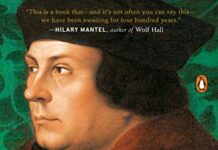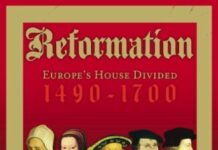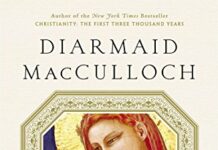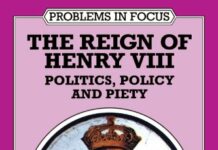
Ebook Info
- Published: 2005
- Number of pages: 884 pages
- Format: PDF
- File Size: 8.70 MB
- Authors: Diarmaid MacCulloch
Description
The Reformation and Counter-Reformation represented the greatest upheaval in Western society since the collapse of the Roman Empire a millennium before. The consequences of those shattering events are still felt today—from the stark divisions between (and within) Catholic and Protestant countries to the Protestant ideology that governs America, the world’s only remaining superpower.In this masterful history, Diarmaid MacCulloch conveys the drama, complexity, and continuing relevance of these events. He offers vivid portraits of the most significant individuals—Luther, Calvin, Zwingli, Loyola, Henry VIII, and a number of popes—but also conveys why their ideas were so powerful and how the Reformation affected everyday lives. The result is a landmark book that will be the standard work on the Reformation for years to come. The narrative verve of The Reformation as well as its provocative analysis of American culture’s debt to the period will ensure the book’s wide appeal among history readers.
User’s Reviews
Reviews from Amazon users which were colected at the time this book was published on the website:
⭐Don’t be put off by the size of this book or the size of the subject. The book will give you the “who, what, where, when and why” of the Reformation in smooth, clear and inviting prose. MacCulloch makes fine and fascinating distinctions about a breathtaking amount of material, as he puts in rich full context a battle of ideas that is still being fought today. For all its brilliance, this book is actually great fun. For the mainstream reader it is a treasure. I can not recommend it enough. — Added 2008. —– Having now spent over a year and a half reading this book, studying in it, underlining passages and writing in just about every margin, I have to return to my review here and try to do justice to the mammoth accomplishment of this work.—- It is a full multi-course education in one of the most baffling and violent periods in history, during which thousands died for varying religious positions, and we in America are some of the inheritors of the violence and theological speculation and doctrinal decisions of these times. —– This book gives full rich portraits of Protestants and Catholics alike, striving to bring to us an understanding of how these men and women of religion saw themselves and their relationship to God, and why they were willing to go to such lengths for their beliefs.—— And, as the jacket copy tells us: “MacCullogh examines the impact of the Reformation on ordinary lives.” —– This is of immense value because we are, I think, still in the midst of religious revolution and reformation today. —- Possibly we always will be.—- As Christians, we are part of a quarreling religion, a religion with great respect for debate and contrary opinion, yet a religion that strives constantly to put an end to all debate with inspired positions. —- It never seems to come to that. —- Our debates, within our denominations, and within the great church as a whole, go on. —This book deals with some of the most vital and most fateful quarrels in which we’ve ever been involved, and to understand ourselves better, we need to know about them. —— I recommend this book whole heartedly for a confrontation with our own religious obsessions and attitudes towards a whole range of life’s most serious questions, including those pertaining to family life. — For those presently watching the new spate of films and mini series about Henry VIII and his daughter, Elizabeth I, this book provides a great resource for examination of the misunderstandings, tragedies and accomplishments of the era which do not always make it to film. —- Obviously people in America in the year 2008 are obsessed with religion, and nothing will help us more with our obsession than valid observations, and insights such as this book provides. Nothing, except prayer, that is, and an educated examination of our own consciences. ——– Let me add on a practical note the book is filled with valuable cross references. When you come to the life of Luther, for example, you’ll find specific page references to Luther elsewhere in the text, and these cross references are of terrific help. The cross references help you to organize what you are discovering here and seeking to absorb, which is, of course, an immense mount. —- For Catholics, this book provides a particularly rich description of what we call the Counter Reformation, and it seems to me that MacCulloch is as insightful and even handed here as he is with Protestant personalities and developments. —– One final note: sink into this book. Sink into it. You may come out disagreeing with some of MacCullogh’s views, but the book is bound to teach you more than you can possibly dream. —- You will want to read biographies of people of whom you perhaps knew nothing before you started here. You will want the education to go on. —- Recommended for everyone — the armchair historian, the scholar, the teacher, the professional historian, the person who just wants to know! — for us all.
⭐A seven-hundred page volume hardly seems well described by the term “introduction,” but after absorbing this sweep of Western Europe’s religious woes there is a better sense of how the term “Reformation” encompasses nearly every aspect of life and culture during its two century span. The theological issues alone could run volumes [and in fact, continue to do so] but what marks this work is its connectedness with the people who lived, warred, worked and believed on the journey to the New Jerusalem.We get a sense of this in the opening essay in which MacCulloch attempts to set the table for the Lutheran event. He discusses 1500 Catholicism under two headings, or pillars as he calls them: the Mass and the papacy. His treatment of the Mass–and its perception of efficacy by believers of the time–is balanced and insightful. Indulgences, in this context, become a cancer on an otherwise useful paradigm or catechesis of merit and spiritual standing. The papacy, on the other hand, was coming off bad times and too preoccupied and turf conscious to excise or even ameliorate its malignancies.Luther said nothing in 1517 that had not been said before on matters of Church reform, but as MacCulloch observes, the arguments quickly became both personal and institutional; he records, for example, tensions between the Dominican and the Augustinian religious orders as well as between the papacy and, well, quite a few folks. Moreover, 1517 was not 1300. The author notes the changes in the political map of Europe, and while nationalism was certainly on the rise, central Europe in particular was better defined as a land of regions, whose boundaries and spheres of influence shifted with amazing velocity.This political substructure is important to recall as the Reformation progressed through its various phases–from radical reform of Western Catholicism to new monarchical ecclesiastical structures to evangelical movement to radical personal piety. The old adage of “cuius region, cuius religio” took on more bite as there were now more “religios” with shades of grey to suit every prince and prelate. MacCulloch is successful in tracing the major princes, theologians, and characters of the era, but it is no easy task. Without belittling the religious issues at hand, the fact is that a city’s creed often shifted with local elections or conditions; one city experienced 70 such shifts in the Reformation era.This leads to a question of how deeply the theological issues of the Reformation permeated the life of European citizenry. MacCulloch gives this question a good amount of thought. Clearly the Peasants War and other conflicts brought untold suffering to millions, though one wonders if religion was the fuel or the match. Certainly one theme of this work is the dozens of worldviews and religious eccentricities that lived just beneath the surface of late medieval Christendom. Virtually all Christian communions gave rise of apocalyptic or millenarian extremism, archaism, magic, anti-Semitism, or simple zaniness.And yet, in an interesting chapter on sexual mores, we get the picture of a citizenry that worked, drank, prayed, and copulated pretty much the same as civil and religious regimes came and passed. Even more to the point, MacCulloch draws his study to its end with a panorama of how two centuries of religious strife created a new sense of self-identity for Europeans. By 1700 one could speak of “choosing religions,” a concept [officially] unthinkable in 1500. The great revival of Biblical devotion led to a curious development–issues over the trustworthiness of the texts themselves, or what later ages would call “biblical criticism.” Galileo’s thorn in the side did not go away; in fact, Descartes, Newton, and other thinkers of the time pursued truth with what they regarded as a kind of methodological purity, untainted by superstition or creed.Thus the tempest that marked the beginning of the Reformation gave way to three irrepressible forces: common sense, exhaustion, and cynicism. The author does not say this quite so bluntly, but the movement to purify and exalt the holy Church of God, after two centuries, had actually succeeded in domesticating, relativizing, and perhaps even marginalizing the Church into something of what we recognize in twenty-first century America.
⭐Well written, full of significant information-like an encyclopedia of middle ages politics & religion
Keywords
Free Download The Reformation in PDF format
The Reformation PDF Free Download
Download The Reformation 2005 PDF Free
The Reformation 2005 PDF Free Download
Download The Reformation PDF
Free Download Ebook The Reformation





